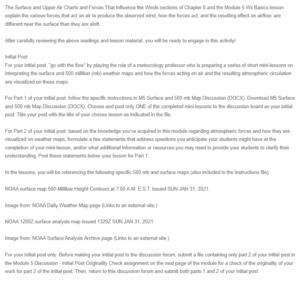Pressure Gradients and Wind Patterns on Surface Maps
Part 1
Lesson Title: Visualizing Pressure Gradient Force and Wind on the Surface Map
On the surface map, large pressure gradients are visualized by tightly packed isobars, indicating strong pressure gradient forces and high winds.
On the surface map shown, a relatively strong pressure gradient is observed off the West Coast and California, further supported by the relatively higher wind speeds on the surface station models in that region of the map.
Small pressure gradients are visualized by loosely packed isobars, indicating relatively weak pressure gradient forces and light winds.
On the surface map shown, a relatively weak pressure gradient is observed over Texas and Oklahoma, further supported by the relatively light winds on the surface station models in that region of the map.
Part 2
What is the relationship between winds and pressure gradients? Pressure gradients are caused by a pressure gradient force that pushes air in the pressure gradient’s direction. The greater the winds, the higher the pressure (Ahrens & Henson, 2021).
How is the wind direction displayed? The horizontal difference in air pressure is referred to as wind. The wind is caused by all of the forces that work in the atmosphere. What generates a significant pressure gradient? Large temperature gradients between cold air behind a cold front and warm air in advance of a cold front create this.
The air on the surface of the earth is made up of millions and millions of air molecules, and the weight of all that air is referred to as air pressure. The lower the air molecules and pressure are, the higher the atmosphere.
High-pressure centres are called anticyclones, and they have clockwise winds whirling around them, whereas low-pressure centres are called cyclones, and they have anticlockwise winds spinning around them (UCAR, 2022).
References
Ahrens, C. D., & Henson, R. (2021). Meteorology today: an introduction to weather, climate, and the environment. Cengage learning.
UCAR, (2022). The Highs and Lows of Air Pressure https://scied.ucar.edu/learning-zone/how-weather-works/highs-and-lows-air-pressure
ORDER A PLAGIARISM-FREE PAPER HERE
We’ll write everything from scratch
Question
The Surface and Upper Air Charts and Forces That Influence the Winds sections of Chapter 8 and the Module 5 Wx Basics lesson explain the various forces that act on air to produce the observed wind, how the forces act, and the resulting effect on airflow, are different near the surface than they are aloft.

Pressure Gradients and Wind Patterns on Surface Maps
After carefully reviewing the above readings and lesson material, you will be ready to engage in this activity!
Initial Post
For your initial post, “go with the flow” by playing the role of a meteorology professor who is preparing a series of short mini-lessons on interpreting the surface and 500 millibar (mb) weather maps and how the forces acting on air and the resulting atmospheric circulation are visualized on these maps.
For Part 1 of your initial post: follow the specific instructions in M5 Surface and 500 mb Map Discussion (DOCX). Download M5 Surface and 500 mb Map Discussion (DOCX). Choose and post only ONE of the completed mini-lessons to the discussion board as your initial post. Title your post with the title of your chosen lesson as indicated in the file.
For Part 2 of your initial post: based on the knowledge you’ve acquired in this module regarding atmospheric forces and how they are visualized on weather maps, formulate a few statements that address questions you anticipate your students might have at the completion of your mini-lesson, and/or what additional information or resources you may need to provide your students to clarify their understanding. Post these statements below your lesson for Part 1.
In the lessons, you will be referencing the following specific 500 mb and surface maps (also included in the instructions file):
NOAA surface map 500-Millibar Height Contours at 7:00 A.M. E.S.T. issued SUN JAN 31, 2021.
Image from: NOAA Daily Weather Map page (Links to an external site.)
NOAA 1200Z surface analysis map issued 1329Z SUN JAN 31, 2021.
Image from: NOAA Surface Analysis Archive page (Links to an external site.)
For your initial post only: Before making your initial post to the discussion forum, submit a file containing only part 2 of your initial post in the Module 5 Discussion – Initial Post Originality Check assignment on the next page of the module for a check of the originality of your work for part 2 of the initial post. Then, return to this discussion forum and submit both parts 1 and 2 of your initial post.

